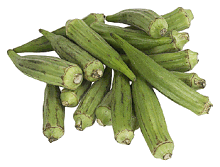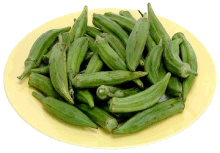|
Okra: Nutrition and Interesting
Insights
of this Ancient Ethiopian Vegetable
by www.SixWise.com
Okra, the slimy but delicious-tasting green veggie that's
popular in Southern, Creole and Cajun cooking, is actually
a tropical herb that's related to cotton, hibiscus, and hollyhock.
|

Okra provides benefits to your digestive tract that
are similar to yogurt's!
|
If you've never tasted it before, okra has a flavor similar
to asparagus and eggplant, and it's popular in much of the
world, including Africa, the Middle East, Greece, Turkey,
India, the Caribbean, South America and the Southern United
States.
Okra originated in Ethiopia
and was cultivated in ancient Egypt. When it first came to
the United States, it was largely used to thicken stews like
gumbo, because the pods release a sticky juice when they're
cut. Today, however, you can find okra sautéed, breaded
and fried, pickled, boiled, stewed, steamed, baked, and even
raw in salads.
Is Okra Nutritious?
Actually, yes. It's an excellent source of fiber, vitamins
C and A, B vitamins, iron and calcium -- and it's very low
in calories. Also:
-
Okra's slimy mucilage binds with and inhibits the absorption
of cholesterol, toxins and bile acids.
-
Okra nourishes the good bacteria (probiotics) in your
intestines, just as yogurt does.
-
Okra can prevent constipation, treat irritable bowels,
heal ulcers and soothe your gastrointestinal tract.
It's even said that rinsing your hair with a concoction of
boiled, sliced okra and a few drops of lemon juice will add
volume and shine to your hair!
|

A popular way to eat okra is breaded and fried ...
but a healthier way would be to try it raw on a salad.
|
Cooking With Okra
When you buy okra, look for tender, firm pods that snap easily
in half. Store them in a paper bag in the warmest part of
your refrigerator, and don't wash them until you're going
to use them (this will make them slimy).
The thing about okra is, the more you cut it, the slimier
it becomes, so if you don't like the stickiness, cut it sparingly.
Also, don't cook it in aluminum, iron or copper pans, as this
can discolor it. Remember, you can also try okra raw, and
this may be the healthiest way, as all
of its nutrients will be preserved.
For a tasty way to try okra tonight, sample this simple okra
stir-fry ... it's fresh, nutritious, and, of course, delicious!
Stir-Fried Okra
Ingredients:
2 cups fresh okra, washed, trimmed, thinly sliced
1 large tomato, peeled and sliced into 8 thin wedges
1/4 cup green onions, sliced, white and green
1 1/2 teaspoons fresh lemon juice
1/4 teaspoon leaf thyme, crushed
1 teaspoon salt
dash pepper
1 tablespoon vegetable oil
2 tablespoons butter
Preparation:
- Prepare all vegetables as indicated and have ready for
cooking. In a small bowl, combine lemon juice, thyme, salt,
and pepper.
- Heat oil and butter in a wok or large skillet. Add vegetables
and seasoning mixture all at once.
- Toss and cook for 5 to 8 minutes. Serves 4
Recommended Reading
Nine
Uncommon "Green Leafy Vegetables" Worth Trying
The
Turnip: Nutrition, Uses and Some Interesting Lore of "One
of the Most Important Vegetables"
Sources
About.com
EzineArticles.com
The
Hindu
FoodReference.com
|